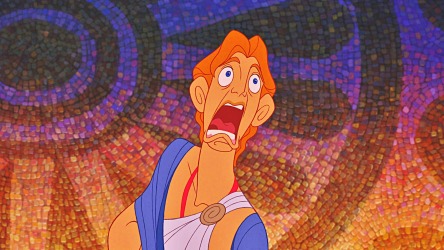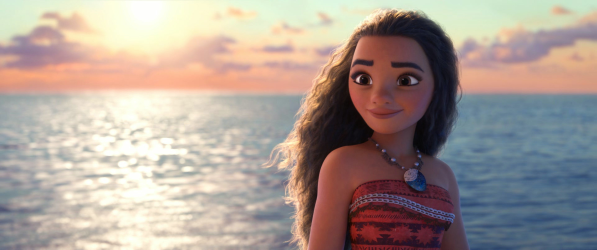I’m at the point—perhaps because I’m just that jaded, or maybe, just maybe, it’s something else—where a review of a kiddie movie is just the hardest thing to do. From the heady first decade of the millennium where every year or so brought us a new, great Pixar film, and all the other studios were putting out A-level efforts to try to compete, we’re at the point now where things feel too cookie-cutter, too formulaic. It’s not just in narrative or the blanding-down required by modern political correctness (Disney has permanent, salaried diversity consultants!) but the cyclical, industry-level tradition of finding something that works and beating it to death until you get enough embarrassing flops to find something new. (Which you’ll then beat to death until it can be milked no further.)

Dwayne Johnson is great in this, but would he have gotten the role if not half Samoan?
Obviously the superhero movies reached that point a few years back. The Star Wars franchise instantly entered that phase once Disney took over.
The princess genre hit that mark in the late ’90s and, Tangled and Frozen notwithstanding, it’s never really recovered. Keep in mind that the inventor of the genre, Mr. Walt Disney made three princess films in toto: Snow White (1938), Cinderella (1950) and Sleeping Beauty (1959). So, in almost 30 years of feature film making, he made about one a decade (and decided after Sleeping Beauty‘s failure that the public didn’t want any more princess stories). Since 1989, the Disney studios have made around ten princess films: Five between 1989 and 1998, and five since 2009 and Moana.
And, if we’re being honest, 1997’s Hercules is basically a princess film in a toga. Point is: That’s a lot of princesses.

You heard me.
Which brings us to Moana, and the number one perpetrator of ’90s princess films, Ron Clements and John Musker (The Little Mermaid, Aladdin, Hercules), who have returned from their exile after the (in many ways under-rated) 2009 flick Princess and the Frog to give us a tale of a Polynesian denies-she’s-a-princess who defies her father and seeks to save the world (which, in Polynesian terms means the little island her tribe lives on) with the help of a former pro-wrestler/demigod.
They get an assist from Big Hero 6’s directing duo, Don Hall and Chris Williams but I can’t really tell what that contribution is. (They’re listed as “co-director”s.)
Like I say, it’s hard to write a review because you’ve seen it before. A lot. Currently this film is sitting above The Little Mermaid review-wise, but I have to believe this will be tempered with time. The music is pretty good here, sure, but it’s not Ashman/Menken good. The mandatory “find myself” song is above par, though the most memorable song, by far, is “You’re Welcome” which is “sung” by Dwayne “The Rock” Johnson as a demigod who is quite taken with his own contributions to humanity. It’s fun. Of course, the “find myself” song is the one that got the Oscar nod (losing the award to a song from La La Land which, of course, I don’t remember at all).
And I put “sung” in scare quotes but The Rock is hands down the best, most memorable part of this film which, I believe, will largely be forgotten and/or blended with the other half-dozen or more princess films of the decade.

“You remember! The one with dark hair!” “Mulan?” “No! The one with dark skin?” “The Princess and the Frog?” “Not THAT dark!” “Jasmine?”
Not saying it’s bad, mind you. Far from it. But it is a lead pipe cinch that the three archetypal Disney princesses are archetypes because for 50 years, they were all there were. There’s a difference between a formula you break out once a decade, and one you use every 2 years.
So I think the only real way to look at this is to look at it in terms of what stands out:
The artwork. Not because it’s especially good—it is, but I’m exhausted writing about how each new Pixar/Disney/Dreamworks animated feature pushes the boundaries of the technology, and you gotta be exhausted reading it. What makes it noteworthy is that it’s a little bit different. The color palette, the Pacific Island style. Even if the movie feels the same in almost every regard to the previous 9 Disney princesses, it looks somewhat different.
Lack of stunt casting. Really, apart from The Rock, the only “famous” face actors in this film are also accomplished voice actors: Alan Tudyk (Frozen, Wreck-It Ralph, Tucker and Dale vs. Evil) and Jemaine Clement (The Lego Batman Movie, What We Do In The Shadows, and a great David Bowie-esque bit on “Rick and Morty”).
The Rock. Stunt casting or no, it’s a perfect role for him. Also, it’s just a little touch but a nice one that the obvious cute sidekick gets left behind in favor of a completely useless one.

Not just a NET negative but literally makes no positive contribution. ’cause it’s a rooster.
Less self-centered. The ’90s princess movies, taken as a whole, are a big middle finger to anything other than the sort of compulsive childish “self-expression” which became vogue in the ’50s (yes, the ’50s!) and which seem to be reaching their peak now. Moana (as a character) is different in that she sublimates her personal desires because it’s the right thing to do. This has to be Lasseter’s influence, as it was the theme of every Pixar movie up to The Incredibles, and it remains a common theme. The cheat is that she’s forced into doing what she wanted to do all along to save her people. (It’s a cheat, but I’ll allow it.)
The climactic battle isn’t as such. Don’t get me wrong: I like a good climactic battle. But what they set up—basically a battle of a demigod versus a demon with some magic cheat for the heroine—would’ve been off point. They essentially cribbed from Miyazaki, and that’s not a bad thing.
Speaking of which, I read someone’s exasperated review of the film, pointing out that Miyazaki is this huge influence on virtually every major American animator and yet not one of them (including Moana) can let their movie breathe. It’s a fair point: There’s a compulsive fear of having things be calm for a moment, almost like they have no faith in the beauty or wonder of the animation they pour their hearts into.
But, look, The Barb liked it, and that’s what counts, right? Gonna be interesting to see whether she keeps this “I love everything!” attitude into her teen years. (And by “everything” I mean “movies”. She’s less sanguine about most of the rest of life.)

“When I was your age, Moana was called ‘Mulan’.”
